Ranks in Air Force JROTC play a pivotal role in shaping the leadership, discipline, and teamwork of young cadets. This guide delves into the intricacies of the rank structure, cadet and officer ranks, and the significance of rank insignia, providing a comprehensive overview of this essential aspect of the Air Force JROTC program.
From the Cadet Airman Basic to the Cadet Colonel, each rank carries distinct responsibilities and requirements, fostering a sense of progression and accomplishment among cadets. Officer ranks, ranging from Cadet Second Lieutenant to Cadet Lieutenant Colonel, offer opportunities for cadets to develop leadership skills and assume greater responsibilities.
Ranks in Air Force JROTC
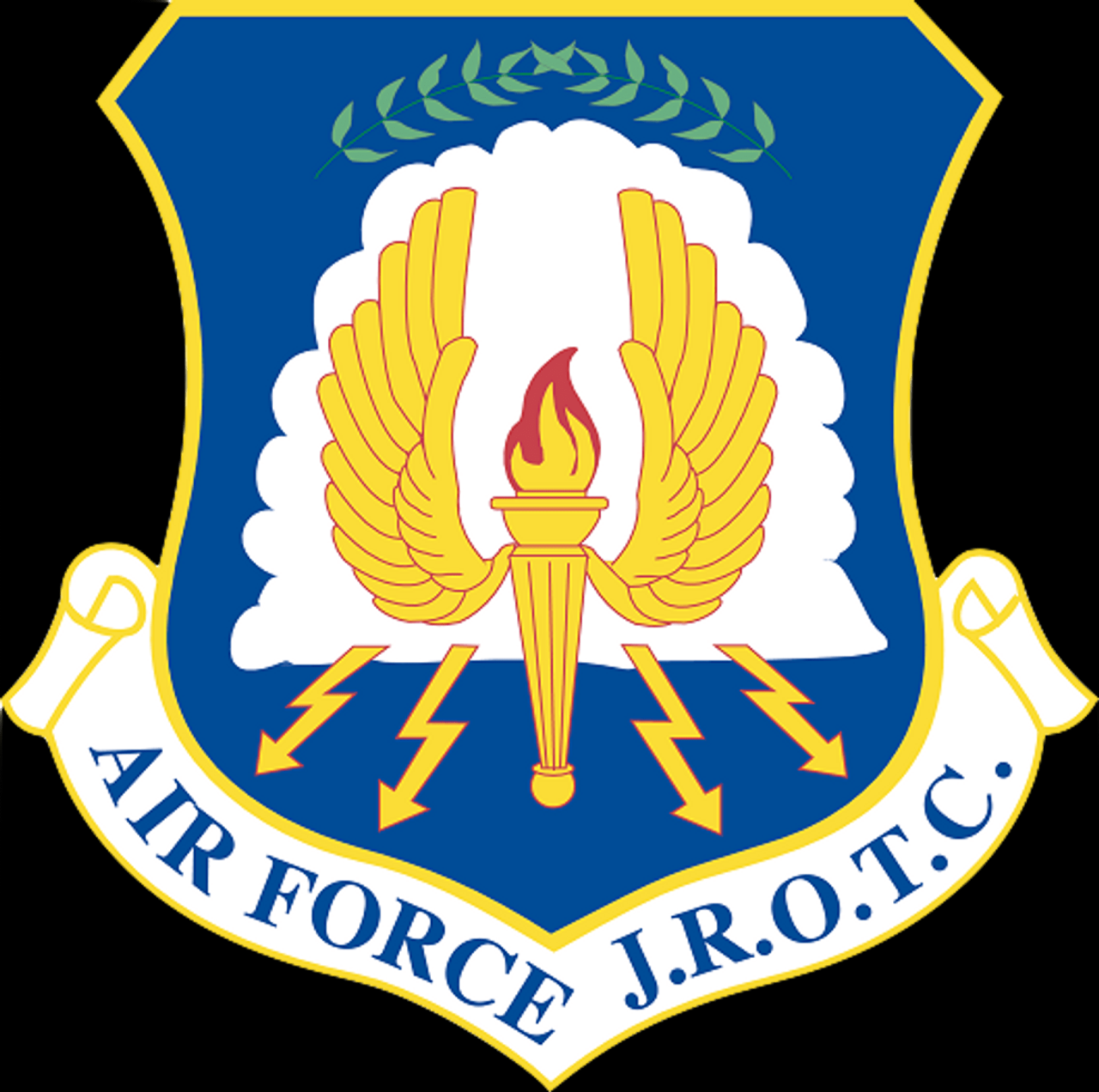
Air Force JROTC is a citizenship and leadership development program that provides high school students with an opportunity to learn about the United States Air Force and develop leadership skills. Cadets in Air Force JROTC are organized into a cadet corps, which is led by cadet officers.
The cadet corps is divided into squadrons, which are led by cadet non-commissioned officers (NCOs).
Hierarchy of Ranks
The hierarchy of ranks in Air Force JROTC is as follows:
- Cadet Airman Basic (AB)
- Cadet Airman (Amn)
- Cadet Airman First Class (A1C)
- Cadet Senior Airman (SrA)
- Cadet Staff Sergeant (SSgt)
- Cadet Technical Sergeant (TSgt)
- Cadet Master Sergeant (MSgt)
- Cadet First Sergeant (1st Sgt)
- Cadet Chief Master Sergeant (CMSgt)
- Cadet Second Lieutenant (2d Lt)
- Cadet First Lieutenant (1st Lt)
- Cadet Captain (Capt)
- Cadet Major (Maj)
- Cadet Lieutenant Colonel (Lt Col)
- Cadet Colonel (Col)
Cadet officers are responsible for leading the cadet corps and ensuring that the cadet corps follows the rules and regulations of the Air Force JROTC program. Cadet NCOs are responsible for assisting the cadet officers in leading the cadet corps.
Insignia and Responsibilities
The following table shows the insignia and responsibilities of each rank in Air Force JROTC:
| Rank | Insignia | Responsibilities |
|---|---|---|
| Cadet Airman Basic (AB) | No insignia | Follows orders from superiors |
| Cadet Airman (Amn) | One chevron | Assists with basic tasks |
| Cadet Airman First Class (A1C) | Two chevrons | Leads small teams |
| Cadet Senior Airman (SrA) | Three chevrons | Supervises larger teams |
| Cadet Staff Sergeant (SSgt) | Three chevrons and one rocker | Manages multiple teams |
| Cadet Technical Sergeant (TSgt) | Three chevrons and two rockers | Provides technical guidance to subordinates |
| Cadet Master Sergeant (MSgt) | Three chevrons and three rockers | Leads large units |
| Cadet First Sergeant (1st Sgt) | Three chevrons and four rockers | Advises the commander on enlisted matters |
| Cadet Chief Master Sergeant (CMSgt) | Three chevrons and five rockers | Senior enlisted advisor to the commander |
| Cadet Second Lieutenant (2d Lt) | One bar | Leads small units |
| Cadet First Lieutenant (1st Lt) | Two bars | Leads larger units |
| Cadet Captain (Capt) | Three bars | Commands squadrons |
| Cadet Major (Maj) | Four bars | Commands groups |
| Cadet Lieutenant Colonel (Lt Col) | Five bars | Commands wings |
| Cadet Colonel (Col) | Six bars | Commands regions |
Cadet Ranks
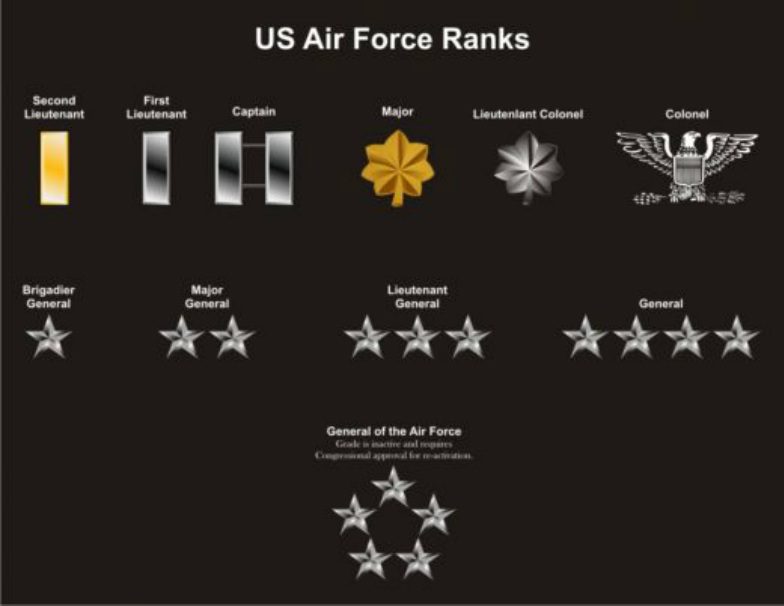
Cadet ranks in Air Force Junior Reserve Officer Training Corps (AFJROTC) reflect the leadership responsibilities and progression of cadets within the program. These ranks provide a framework for developing leadership skills, fostering teamwork, and instilling discipline.
In the realm of Air Force JROTC, ranks play a crucial role in establishing order and fostering a sense of hierarchy. These ranks, ranging from cadet airman to cadet lieutenant colonel, mirror those found in the actual Air Force, providing students with a taste of military discipline and leadership.
Like the intricate words of my love in High Valyrian , the ranks in Air Force JROTC carry a profound significance, shaping the experiences and aspirations of young cadets.
Cadets advance through the ranks based on their performance, leadership abilities, and time in the program. Each rank carries specific requirements and responsibilities, contributing to the overall success and effectiveness of the AFJROTC unit.
Cadet Airman Basic
- Entry-level rank for all new cadets
- Responsibilities include following instructions, maintaining a clean uniform, and participating in basic drills
- Requirements: None
Cadet Airman
- Promoted after completing six weeks of basic training
- Responsibilities include assisting Cadet Airman Basics and participating in more advanced drills
- Requirements: Completion of basic training
Cadet Senior Airman
- Promoted after six months in the program
- Responsibilities include leading small teams of cadets and assisting in training new cadets
- Requirements: Completion of six months in the program and demonstration of leadership skills
Cadet Staff Sergeant
- Promoted after one year in the program
- Responsibilities include leading larger teams of cadets and assisting in the planning and execution of unit activities
- Requirements: Completion of one year in the program, demonstration of leadership skills, and completion of additional training
Cadet Technical Sergeant
- Promoted after two years in the program
- Responsibilities include serving as a role model for junior cadets and assisting in the overall management of the unit
- Requirements: Completion of two years in the program, demonstration of exceptional leadership skills, and completion of additional training
Cadet Master Sergeant
- Promoted after three years in the program
- Responsibilities include serving as the highest-ranking enlisted cadet in the unit and assisting the Cadet Commander in the day-to-day operations of the unit
- Requirements: Completion of three years in the program, demonstration of exceptional leadership skills, and completion of additional training
Cadet Chief Master Sergeant
- Promoted after four years in the program
- Responsibilities include serving as the highest-ranking cadet in the unit and leading the Cadet Wing
- Requirements: Completion of four years in the program, demonstration of exceptional leadership skills, and completion of additional training
Cadet Second Lieutenant
- Promoted after completion of the AFJROTC Leadership Education and Training (LET) program
- Responsibilities include serving as a junior officer in the unit and assisting the Cadet Commander in the planning and execution of unit activities
- Requirements: Completion of the LET program and demonstration of leadership skills
Cadet First Lieutenant
- Promoted after one year as a Cadet Second Lieutenant
- Responsibilities include serving as the Executive Officer of the unit and assisting the Cadet Commander in the overall management of the unit
- Requirements: Completion of one year as a Cadet Second Lieutenant and demonstration of leadership skills
Cadet Captain
- Promoted after two years as a Cadet First Lieutenant
- Responsibilities include serving as the Cadet Commander of the unit and leading the entire Cadet Wing
- Requirements: Completion of two years as a Cadet First Lieutenant and demonstration of exceptional leadership skills
Cadet Colonel
- Highest rank attainable by a cadet in AFJROTC
- Responsibilities include serving as the Group Commander of multiple units and overseeing the entire AFJROTC program at the school
- Requirements: Completion of three years as a Cadet Captain and demonstration of exceptional leadership skills
Officer Ranks
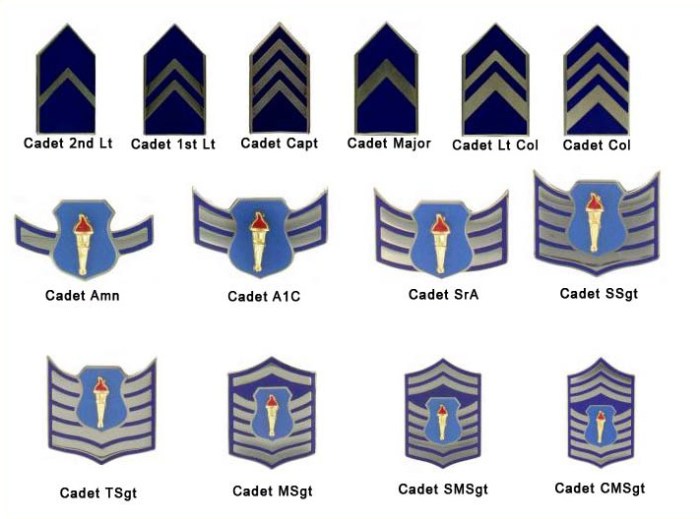
In Air Force JROTC, cadets can progress through various officer ranks, each with its own responsibilities and privileges. These ranks provide cadets with leadership opportunities and help them develop essential skills for future success.
Cadets are selected for officer positions based on their leadership abilities, academic performance, and overall conduct. They must demonstrate a strong commitment to the program and a willingness to take on additional responsibilities.
Cadet Second Lieutenant
- Serves as the assistant to the Cadet First Lieutenant
- Assists with planning and conducting cadet activities
- Provides guidance and support to lower-ranking cadets
Cadet First Lieutenant
- Leads and manages a flight of cadets
- Plans and conducts cadet activities
- Evaluates and provides feedback to lower-ranking cadets
Cadet Captain
- Serves as the commander of a squadron of cadets
- Manages the day-to-day operations of the squadron
- Represents the squadron at official events
Cadet Major
- Serves as the executive officer of a group of squadrons
- Assists the Cadet Lieutenant Colonel with the management of the group
- Provides guidance and support to cadet officers
Cadet Lieutenant Colonel
- Serves as the commander of a group of squadrons
- Manages the overall operations of the group
- Represents the group at official events
Rank Structure and Leadership
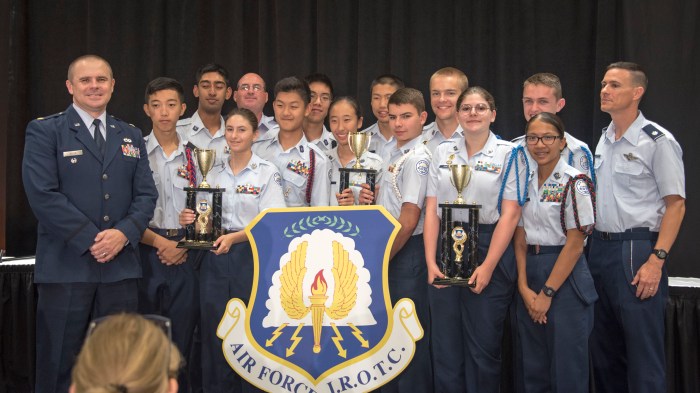
The rank structure in Air Force JROTC is crucial as it establishes a clear hierarchy, defines responsibilities, and fosters a sense of order and discipline. It promotes leadership by providing cadets with opportunities to lead and be led, developing their abilities to motivate, inspire, and make decisions.
Importance of Rank Structure
The rank structure ensures that each cadet understands their role and responsibilities within the unit. It facilitates effective communication, delegation of tasks, and accountability. The clear lines of authority allow for efficient decision-making and smooth functioning of the organization.
Leadership Development
Cadets in higher ranks are expected to demonstrate leadership qualities, such as integrity, initiative, and problem-solving skills. They mentor and guide lower-ranking cadets, fostering a culture of support and growth. This practical experience in leadership helps cadets develop essential skills for future endeavors.
Teamwork and Discipline
The rank structure emphasizes teamwork and cooperation. Cadets learn to respect and support each other, regardless of their rank. The discipline instilled through the rank system fosters a sense of accountability and adherence to rules and regulations.
Examples of Leadership
Cadets in higher ranks demonstrate leadership qualities in various ways. For instance, a cadet colonel may effectively manage the unit’s operations, delegate tasks, and motivate their subordinates. A cadet lieutenant may excel in leading a flight of cadets, providing guidance and support.
Rank Insignia and Uniforms
In Air Force JROTC, rank insignia is a crucial aspect of the uniform, symbolizing authority, responsibility, and accomplishment. Wearing rank insignia on uniforms holds significant importance.
Rank Insignia on Uniforms, Ranks in air force jrotc
Rank insignia is displayed on the collar, shoulder epaulettes, and sleeves of the Air Force JROTC uniform. Each rank has a distinct insignia, which is designed to be easily recognizable and distinguishable.
- Collar Insignia:The collar insignia consists of silver or gold bars and stars, indicating the cadet’s rank.
- Shoulder Epaulettes:The shoulder epaulettes display the Air Force JROTC emblem and the cadet’s rank.
- Sleeve Insignia:The sleeve insignia is worn on the left sleeve and indicates the cadet’s unit and position.
Wearing rank insignia on uniforms signifies the cadet’s authority and responsibility within the Air Force JROTC program. It promotes discipline, fosters respect, and enhances the overall appearance of the cadet corps.
Earning and Maintaining Rank
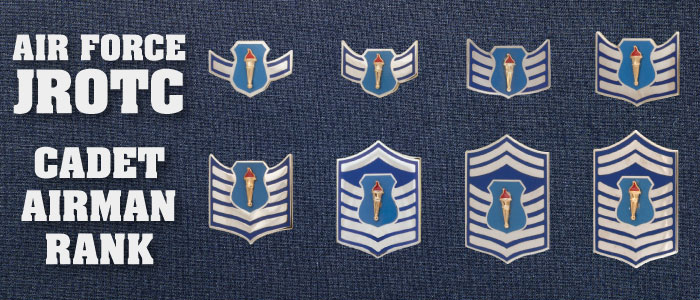
Cadets in Air Force JROTC earn and maintain their rank through a combination of evaluations, performance, and conduct. Evaluations are conducted regularly by instructors and assess cadets’ knowledge, skills, and leadership abilities. Performance refers to cadets’ active participation in JROTC activities, including drill, physical fitness, and community service.
Conduct encompasses cadets’ behavior, appearance, and adherence to JROTC regulations.
Criteria for Earning Rank
To earn a rank, cadets must meet the following criteria:
- Pass a written examination on JROTC knowledge
- Demonstrate proficiency in drill and ceremonies
- Maintain a satisfactory grade point average
- Participate actively in JROTC activities
- Exhibit positive conduct and behavior
Maintaining Rank
Once cadets have earned a rank, they must maintain it by continuing to meet the above criteria. Cadets who fail to meet these standards may be demoted or removed from their position.
Tips for Success
Here are some tips for cadets on how to succeed and advance in rank:
- Study hard and pass your written examinations
- Practice drill and ceremonies regularly
- Maintain a good grade point average
- Participate actively in JROTC activities
- Be a role model for other cadets
- Set goals and work hard to achieve them
Rank and College Applications
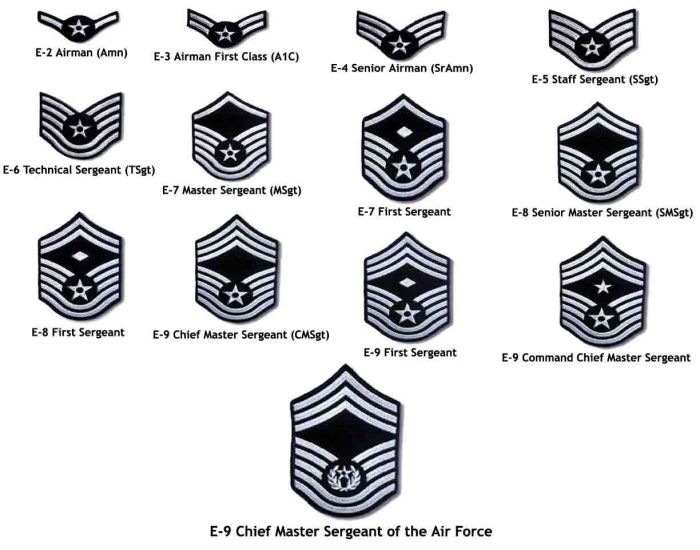
Ranks in Air Force JROTC provide cadets with valuable leadership experience and demonstrate their commitment to excellence. These qualities are highly sought after by colleges and universities.
Many colleges and universities recognize JROTC rank and may give credit for it in the form of advanced placement or college credits. For example, the University of North Carolina at Chapel Hill offers up to six semester hours of credit for cadets who have achieved the rank of Cadet Lieutenant Colonel or higher.
Examples of Successful College Admissions
- Cadet Colonel John Smith was accepted to the United States Military Academy at West Point with a full scholarship.
- Cadet Lieutenant Colonel Mary Jones was offered a full academic scholarship to the University of California, Berkeley.
- Cadet Major Michael Brown was accepted to Harvard University with a partial scholarship.
FAQ Corner: Ranks In Air Force Jrotc
What is the highest rank a cadet can achieve in Air Force JROTC?
Cadet Colonel
How are cadets selected for officer positions?
Through a competitive selection process based on leadership skills, academic performance, and conduct
What are the benefits of earning a high rank in Air Force JROTC?
Recognition in college applications, opportunities for leadership development, and potential scholarships